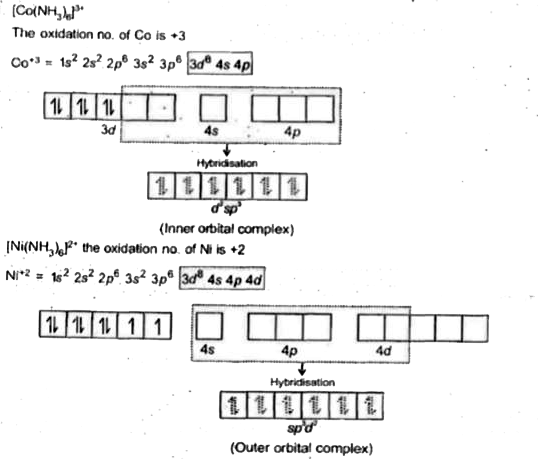Explain [Co(NH3)6]3+ is an inner orbital complex whereas [Ni(NH3)6]2+ is an outer orbital complex.
[CO(NH3)6]3+
The oxidation no. of Co is +3
Co3+=1s22s22p63s23p63d(6)4s4p
Topper's Solved these Questions
- BOOK - AAKASH INSTITUTECHAPTER - ALCOHOLS, PHENOLS AND ETHERSEXERCISE - Try yourself4videos
ALCOHOLS, PHENOLS AND ETHERS
- BOOK - AAKASH INSTITUTECHAPTER - ALCOHOLS, PHENOLS AND ETHERSEXERCISE - Exercise40videos
ALCOHOLS, PHENOLS AND ETHERS
- BOOK - AAKASH INSTITUTECHAPTER - ALCOHOLS, PHENOLS AND ETHERS EXERCISE - Try Yourself5videos
ALCOHOLS, PHENOLS AND ETHERS
Similar Questions
Knowledge Check
- Question 1 - Select One
The questions given below consist of Assertion (A) and Reason (R ) . Use the following key to select the correct answer.
[FeF6]4− is a paramagnetic complex while [Fe(CN)4−6] is a diamagnetic complex .
Reason : [FeF6]4− is an outer orbital complex whereas [Fe(CN)6]4− is an inner orbital complex .AIf both assertion and reason are correct and reason is correct explanation for assertion .BIf both assertion and reason are correct but reason is not correct explanation for assertion .CIf assertion is correct but reason is incorrectDIf both assertion and reason are incorrect - Question 2 - Select One
A: [Cr(H2O)6]3+ is Inner orbital complex.
R: H2O is strong ligand generallyAIf both Assertion & Reason are true and the reason is the correct explanation of the assertion, then mark (1)BIf both Assertion & Reason are true but the reason is not the correct explanation of the assertion, then mark (2).C) If Assertion is true statement but Reason is false, then mark (3).DIf both Assertion and Reason are false statements, then mark (4) - Question 3 - Select One
Assertion: Complex ion [Co(NH3)6]2+ is readily oxidized to [Co(NH3)6]3+
Reason: Unpaired electron in complex ion [Co(NH3)6]2+ is present in 4p orbital.AIf assertion is true but the reason is falseBIf assertion is false but reason is trueCIf both assertion and reason are true and the reason is the correct explanation of assertionDIf both assertion and reason are true but reason is not the correct explanation of assertion
[CoF6]3− forms outer orbital complexes while (Co(CN)6]3−forms inner orbital complexes. Why
View SolutionIn the following questions , a statement of assertion (A) is followed by a statement of reason (R).
A: [Co(NH3)6]+3 is a diamagnetic complex.
R: [Co(NH3)6]+3 is a octahedral shape.View SolutionHow many of the following complexes are correctly matched with given properties ?
(a)[Ni(NH3)6]2+-Octahedral outer orbital complex and two unpaired electrons.
(b)[Cr(NH3)6]3+-Octahedral inner orbital complex and one unpaired electron.
( c)[Zn(NH3)6]2+-Octahedral outer orbital complex and diamagnetic.
(d)[Pt(NH3)4]2+-Square planar and diamagnetic
(e)[Co(SCN)4]2−-Tetrahedral and three unpaired electrons.
(f)[NiBr2(PPh3)2]-Square planar and diamagnetic.View SolutionWhat is the IUPAC name of complex [Ni(NH3)6]Cl2?
View SolutionAssertion: Complex ion [Co(NH3)6]2+ is readily oxidized to [Co(NH3)6]3+
Reason: Unpaired electron in complex ion [Co(NH3)6]2+ is present in 4p orbital.View Solution

